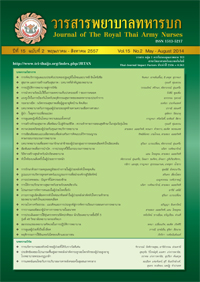การบริโภคเครื่องดื่มแอลกอฮอล์ของครอบครัวไทย Thai Family Alcohol Consumption
Keywords:
การบริโภคเครื่องดื่มแอลกอฮอล์, ครอบครัวไทย, Alcohol Consumption, Thai FamilyAbstract
การวิจัยผสมผสานครั้งนี้ เพื่อสำรวจการบริโภคเครื่องดื่มแอลกอฮอล์ของครอบครัว และหากลยุทธ์การช่วยลดการบริโภค เครื่องดื่มแอลกอฮอล์ของครอบครัว แบบวัดการบริโภคเครื่องดื่มแอลกอฮอล์ของ Mabjabok ถูกประยุกต์เพื่อใช้สอบถามสมาชิก ในครอบครัว 400 คน และเลือกตัวแทนชุมชน 50 คน แบบเจาะจง เพื่อสัมภาษณ์เจาะลึก ก่อนวิเคราะห์ข้อมูลเชิงเนื้อหา เพื่อร่าง กลยุทธ์การช่วยเหลือจากชุมชน
ผลการวิจัยพบว่า สมาชิกในครอบครัวหาซื้อเครื่องดื่มแอลกอฮอล์ได้ง่ายตามร้านขายของชำใกล้บ้าน (ร้อยละ 71.7) ส่วนใหญ่บริโภคเบียร์ 1 - 2 กระป๋อง (ร้อยละ 70.7) เมื่อมีโอกาสพิเศษ (ร้อยละ 50.8) โดยเคยคิดว่าตนเองควรลดปริมาณลง เพราะ ต้องเสียค่าใช้จ่ายจำนวนมาก (ร้อยละ 52.9) แต่ 132 คน คิดว่าไม่สามารถเลิกได้ในอนาคต เนื่องจากต้องเข้าสังคม (ร้อยละ 69.1) ดังนั้นชุมชนจึงได้พัฒนา 3 กลยุทธ์เพื่อลดการบริโภคเครื่องดื่มแอลกอฮอล์ในครอบครัวคือจำกัดการขายเครื่องดื่มแอลกอฮอล์ใน ชุมชนงดการเลี้ยงเครื่องดื่มแอลกอฮอล์ในการจัดงานทุกชนิดในชุมชน และสร้างอาชีพในชุมชน
ผลการศึกษาครั้งนี้ทำให้เห็นพฤติกรรมการบริโภคเครื่องดื่มแอลกอฮอล์ของครอบครัวไทย และความร่วมมือของชุมชน ที่สำคัญยังเป็นแนวทางสำหรับผู้กำหนดนโยบายท้องถิ่นในการออกกฎข้อบังคับ เพื่อลดการบริโภคเครื่องดื่มแอลกอฮอล์ของครอบครัว การวิจัยครั้งต่อไปจึงควรดำเนินการตามกลยุทธ์ที่ชุมชนวางไว้
The purposes of this Mix Method study were to survey family alcohol consumption and to develop strategies for reducing family alcohol consumption. Mabjabok Alcohol Consumption questionnaires were supplied to 400 family members. Purposive sampling was used to recruit a sample of 50 community representatives for in-depth interview. Then, content analysis was performed to draft community support strategies.
The findings revealed that family members easily bought alcohol at places near their houses (71.7%). The majority of participants drank 1-2 cans of beer (70.7%). Those that drank on special occasions were (50.8%). Participants that wanted to reduce drinking because they spent too much on alcohol expenditure were (52.9%). However, 132 participants expect that they cannot abstain in the future because they always have social participation (69.1%). Therefore, the community developed 3 strategies for reducing family drinking: the restriction of buying alcohol in the community; free alcohol party in the community; and the improvement of employment in the community.
The study findings reflected Thai family drinking and community participation. Importantly, the findings have implications for local policy makers seeking to reduce family alcohol consumption. Further research design should be developed with interventions focused on community support strategies.
Downloads
Downloads
How to Cite
Issue
Section
License
บทความหรือข้อคิดเห็นใดใดที่ปรากฏในวารสารพยาบาลทหารบกเป็นวรรณกรรมของผู้เขียน ซึ่งบรรณาธิการหรือสมาคมพยาบาลทหารบก ไม่จำเป็นต้องเห็นด้วย
บทความที่ได้รับการตีพิมพ์เป็นลิขสิทธิ์ของวารสารพยาบาลทหารบก
The ideas and opinions expressed in the Journal of The Royal Thai Army Nurses are those of the authors and not necessarily those
of the editor or Royal Thai Army Nurses Association.






